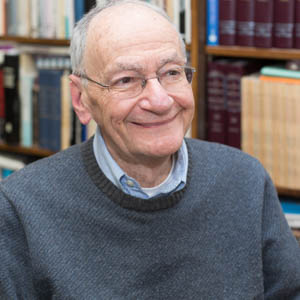Justice and Capital Punishment

Rabban Shimon ben Gamliel, the spiritual leader of Palestinian Jewry in the disordered decades after the Bar Kokhba rebellion (132-135 C.E.), firmly believed that, “The world rests on three things: On justice, on truth and on peace, as it is written (Zechariah 8:16) ‘With truth, justice and peace shall you judge in your gates.'” (Pirkei Avot 1:18). His pronouncement was clearly a vision for reconstituting a society wrecked by the havoc of war. The precondition for a peaceful civil society was a system of administering justice on the basis of truth. A viable body politic needed a corpus of laws drafted equitably and applied fairly.
The biblical narrative affirms this precondition. Before Moses received God’s revelation at Mount Sinai, which is thoroughly legal in character, he was advised by Jethro, his father-in-law, to devise a judicial system that would dispense justice with integrity. To achieve equity, Moses did not have to adjudicate every dispute himself. A graded system of courts presided over by “men who fear God, trustworthy men who spurn ill-gotten gain,” (Exodus 18:21) would do just fine. Divine revelation was only as good as its human mediation. Many a noble piece of legislation gets fouled up by corrupt application.
It is for this reason that the Talmud expatiates on the importance of the judicial function. Two generations after Shimon ben Gamliel, R. Yonatan, another Palestinian sage, declared that, “Any judge who adjudicates a case with absolute integrity causes God’s presence to be felt in Israel’s midst” (BT Sanhedrin 7a). Much later still, R. Hiyya bar Rav, a Babylonian sage, topped R. Yonatan: “Any judge who adjudicates merely one case in a short time but with absolute integrity is regarded as a cohort of the Lord’s in the work of creation” (BT Shabbat 10a). In other words, quality trumps quantity. One need not sit like Moses “from morning until evening” (Exodus 18:13) to help sustain the world. Back in Palestine, Resh Lakish put the sanctity of the office in cultic terms: “Anyone who appoints a judge unworthy of the post is guilty of planting an idolatrous object near the Temple altar”. Thus, judges were expected to don tallitot, when their court was in session. The religious garment symbolized the awesome task ahead (BT Sanhedrin 7a).
This week’s parashah with its far-reaching legal codification, informs vast tracts of the Talmud. My preference, for the moment, is to focus on how rabbinic law came to handle capital cases. The Rabbis indisputably curbed the explicit and expansive use of capital punishment condoned by the Torah. To minimize mistakes, they systematically gave the accused the benefit of the doubt. Now, it may be that the body of procedural law pertaining to capital cases is largely theoretical. We are told by the Talmud itself that some forty years before the destruction of the Second Temple, the Sanhedrin of seventy-one justices (the equivalent of the supreme court of the second Jewish commonwealth) left the precincts of the Temple and ceased adjudicating capital cases (BT Sanhedrin 41a). Regardless, the procedures delineated, aspire to a standard of justice driven by the loftiest of human values. Modern Israel’s exemplary forbearance on capital punishment has deep Jewish roots.
According to the Mishnah, capital cases were to be tried by a court with no less than twenty-three judges, whereas civil cases needed only three judges. Capital cases allowed for no circumstantial evidence. Witnesses had to be carefully examined. They were required to know the accused personally, warn him or her beforehand not to commit the crime and see the crime committed with their own eyes Once the testimony had been gathered and scrutinized, the judges were to take up the possibility of the defendant’s innocence before they considered grounds for conviction. Conviction called for a majority of at least two votes and not just one. Moreover, voting went by rank from the least to the most learned and experienced judge in order to avoid intimidation. Once judges indicated that they leaned toward acquittal they could no longer argue for conviction. Nor were the judges permitted to render a decision in undue haste. Before making a final determination, they had to sleep on the case. That is why capital cases were never heard on the eve of a holiday or on the eve of Shabbat. Though a decision to acquit could not be overturned, a guilty verdict was always reversible (Sanhedrin chapters 4 and 5).
Most revealing of the generous spirit of these procedural constraints is the counter- intuitive rule that if all the judges found the accused guilty, the defendant was to be immediately acquitted. Justice turned on debate and unanimity was suspect. (BT Sanhedrin 17a).
If the essence of justice then is procedural, rabbinic law strove for a system that precluded capital punishment. The Mishnah termed a court that executed a defendant once in seven years as wayward (Makkot1:10). The reason, I think, is twofold. As stated by the Mishnah (Sanhedrin 4:5), every person is of supreme importance, because eons ago human life started with but one pair of single human beings. Unstated, however, but implicit, is the awareness that our common humanity makes us decidedly fallible. Surely, the most basic requirement of any legal system must be not to do further harm; that is, not to compound the injustice already inherent in the crime by committing a judicial error, especially one that is irreversible.
The publication and distribution of Chancellor Schorsch’s commentary on Mishpatim are made possible by a generous grant from Rita Dee and Harold (z”l) Hassenfeld.



